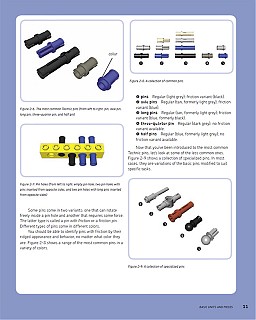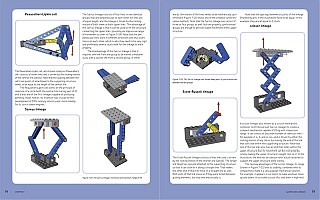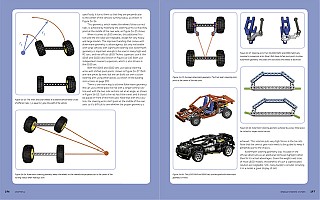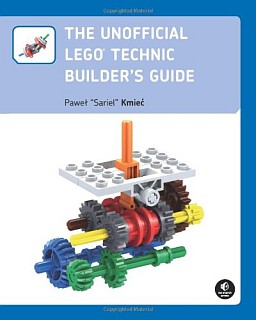 This book is the ultimate reference guide / helper when working with LEGO Technic pieces. Kmiec discusses the different types of LEGO Technic pieces from beams to gears to bushings to pins organized neatly into different related sections. For example, Chapter 5 Gears and Power Transmission Basics provides not just an inventory of the gears available but also a discussion on backlash (the amount of play between gears that have been mated), efficiency, rotational direction, and more. Another example is shown on the left where Kmiec describes the different pins that are commonly available and their differences.
This book is the ultimate reference guide / helper when working with LEGO Technic pieces. Kmiec discusses the different types of LEGO Technic pieces from beams to gears to bushings to pins organized neatly into different related sections. For example, Chapter 5 Gears and Power Transmission Basics provides not just an inventory of the gears available but also a discussion on backlash (the amount of play between gears that have been mated), efficiency, rotational direction, and more. Another example is shown on the left where Kmiec describes the different pins that are commonly available and their differences. One of my favorite chapters was Chapter 7 Levers and Linkages where I not only learned how to best use LEGO pieces for transforming one motion into another, but also found that I was learning mechanics (and in a few cases relearning forgotten information). Seeing concepts like mechanical advantage not just discussed or demonstrated on paper but being able to build a tangible example helps cement the concept and its usage into the mind. If only I had read this book and played around with these LEGO pieces back in high school!
One of my favorite chapters was Chapter 7 Levers and Linkages where I not only learned how to best use LEGO pieces for transforming one motion into another, but also found that I was learning mechanics (and in a few cases relearning forgotten information). Seeing concepts like mechanical advantage not just discussed or demonstrated on paper but being able to build a tangible example helps cement the concept and its usage into the mind. If only I had read this book and played around with these LEGO pieces back in high school! There were a ton of sections that I read with great interest as I had never even considered the issues or problems with building with LEGO (and, by extension, real life). One example that stands out in my mind is the discussion on the need for different turning radii of inner and outer turning wheels as well as how Ackermann steering geometry works and how to construct linkages to prevent tire slippage.
There were a ton of sections that I read with great interest as I had never even considered the issues or problems with building with LEGO (and, by extension, real life). One example that stands out in my mind is the discussion on the need for different turning radii of inner and outer turning wheels as well as how Ackermann steering geometry works and how to construct linkages to prevent tire slippage.I was thinking about including the table of contents here as a way to show how complete this book is, but once I took another look at it, it seemed to be way to long. The book really does cover all the basics and then builds on those for more complex concepts including eleven different transmissions ranging from a 2-speed synchronized transmission to a 5-speed linear transmission to a continuously variable transmission (using rubber bands in lieu of hydraulics), a variety of different suspensions, pneumatic engines, and more. You can check out the table of contents and view several pages with Amazon's Look Inside Feature.
 This book is highly recommended for anyone who is interested in mechanics or just likes playing with LEGO.
This book is highly recommended for anyone who is interested in mechanics or just likes playing with LEGO.Purchase The Unofficial LEGO Technic Builder's Guide at Amazon.com through one of the links on this page and a portion of the sale will go to help maintain Cooking For Engineers.
Related Articles

Using the term "LEGOs" is a misnomer. The entire game system is called LEGO; it's based on the Danish "leg godt", which means "play well".
The individual pieces aren't "Legos". They're LEGO pieces or - even more simply - just called bricks.
Put another way, LEGO is a game. The bricks are the pieces.
Sorry, I had to get that off my chest. You're an engineer, I'm a language geek.
Keep up the good work on the CFE site!
I purchased the book within seconds of reading it -- this is just the book I've been looking for (unconsciously, deep down in my soul :) )